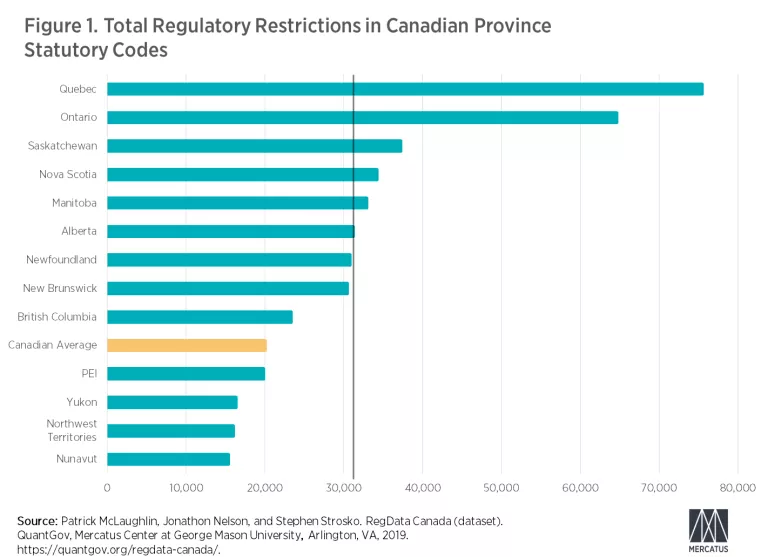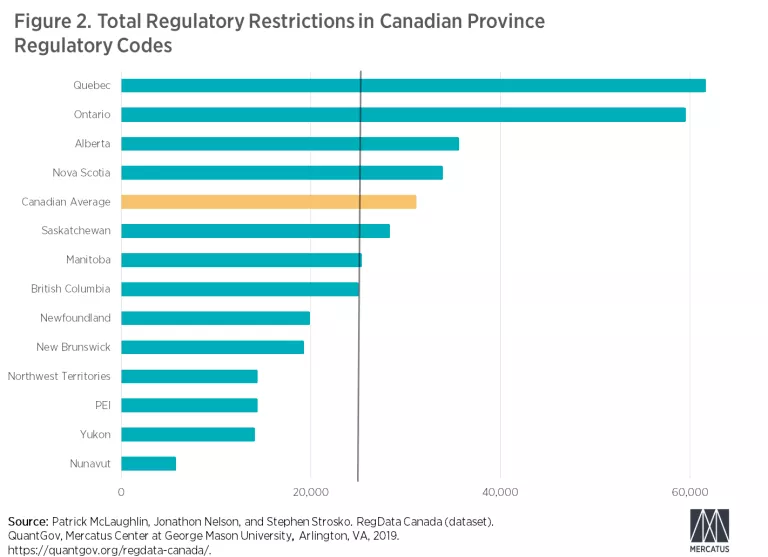- | Regulation Regulation
- | Expert Commentary Expert Commentary
- |
Announcing an Updated Edition of RegData Canada
Dataset quantifies regulatory and statutory restrictions in Canadian provinces
In the past, economic research on regulation was difficult because there was not much data to quantitatively analyze regulatory codes and their effects on the economy. Since 2012, the RegData Project by the Mercatus Center has provided an objective and replicable means of quantifying the size and scope of regulations.
The RegData project began by proposing and implementing an objective approach to quantifying the number of regulatory restrictions in the US Code of Federal Regulations. RegData defines regulatory restrictions as the occurrence of restrictive terms such as “shall” and “must,” which are indicative of individual commands within the regulatory text. In addition, RegData determines which agencies issued the restrictions, and using machine learning algorithms, predicts which industries are targeted by those regulatory restrictions.
Since the first edition of RegData, the project has expanded to cover other jurisdictions, including Canada (federal and province), Australia (federal), and the US states. The first edition of the Canada RegData project quantified the number of regulatory restrictions and the affected industries in both Canada’s federal and individual provincial regulatory codes.
In September 2019, the Mercatus Center completed an updated edition of the Canadian restrictions. In addition to quantifying restrictions found in the regulatory code, the 2019 edition of the project also includes restrictions found in statutes at both the federal and provincial levels. Statutes (sometimes called “acts”) are laws passed by Parliament, while regulations are the rules that address more detailed application of the law. The federal data (both statutes and regulations) spans from 2006-2019, and the provincial data on regulations spans from 2018-2019. The provincial data on statutes only available for 2019.
The Canada federal regulatory code is quite large, composed of about 11.5 million words, including 87,525 regulatory restrictions. The statutory code is slightly smaller, with about 9.7 words and 72,467 restrictions.
The average provincial regulatory and statutory codes are significantly smaller than the federal codes. The average provincial regulatory code contains about 2 million words and 20,000 restrictions, and the average statutory code contains about 2.9 million words and 31,000 restrictions. See the charts below for the restriction counts from each provincial regulatory and statutory code. The vertical line shows median restriction count.

In comparison, as of September 17, 2019, the US has nearly 103 million words, with 1,076,859 restrictions, over ten times more restrictive than the Canada federal regulatory code. The average US state regulatory code contains about 8 million words with 115,000 restrictions, significantly larger and more restrictive than the average Canadian provincial regulatory code. In fact, the average state regulatory code contains more restrictions than the federal Canadian regulatory code, though the federal Canadian code contains more words.

RegData Canada allows researchers to explore previously difficult-to-answer questions about the effect of regulation on Canada’s economy. When combined with US RegData, researchers will be able to explore the differences between the two countries’ regulatory systems and their effect on their respective economies.
RegData Canada can also help provincial leaders to develop a baseline for future regulatory reform, identify areas of their code that can be improved, and help track their progress. We have already seen successful regulatory reform efforts in British Columbia. Between 2001 and 2018, British Columbia cut their regulations nearly in half. RegData Canada will enable leaders in other provinces to pursue similar reforms.
If you would like to learn more about projects like the RegData Canada, sign up for the QuantGov newsletter. For a high-level exploration of the data, check out the RegCensus Explorer. Researchers and others looking to analyze the data can find RegData Canada here.